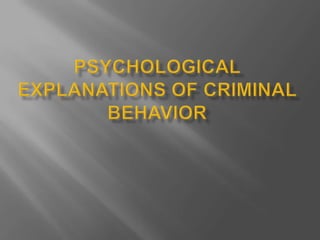
Criminal Behavior Psychological Theories
- 1. Psychological Explanations of Criminal Behavior
- 2. I. Early Explanations A. Demonic Possession B. Physical Shape 1. Criminals are throwbacks marked by huge jaws, asymmetrical faces, and large ears. C. Mental Retardation
- 3. Early Explanations, cont. D. Rational Choice 1. All decisions, even criminal ones, are the result of rational choice. a. Rewards can be emotional as well as financial 2. Offenders weigh their personal needs against the difficulty and risk of committing a crime. 3. Fear of punishment has a deterrent effect on choice to commit crime. 4. Swift and certain punishment is the best way to control crime.
- 4. II. Major Theories A. Psychodynamic Perspective 1. Based on the idea of psychoanalysis developed by Freud. 2. Human personality contains a three-part structure. a. Id (pleasure principal)—respresents unconscious biological drives, wants instant gratification b. Ego (reality principal)—takes into account practical considerations and social conventions; counters the id. c. Superego (the conscience)—forces the ego to control the id. Incorporates moral standards of society and determines right from wrong.
- 6. 3. Emphases are on early childhood experiences and how a person deals with traumatic events. a. Criminals have weak egos and damaged personalities. B. Behavior Theory People are not born with violent tendencies but learn aggression through life experiences. Violence is learned through behavior modeling. Family members Environmental experiences Mass Media (see Bobo Doll experiment pictures, next slide, from Albert Bandura’s research.)
- 7. Caption states, “Photographs of children imitating the aggressive behavior of the female model they had observed on film.”
- 8. 3. Studies a. Albert Bandura—Bobo Doll Experiment (1961) b. Stanley Milgram—Behavioral Study of Obedience (early 1960s) c. Philip Zimbardo—Stanford Prison Experiment (1971) Link: Philip Zimbardo--How People Become Monsters...Or Heroes
- 9. "If only there were evil people somewhere insidiously committing evil deeds, and it were necessary only to separate them from the rest of us and destroy them. But the line dividing good and evil cuts through the heart of every human being. And who is willing to destroy a piece of his own heart?" -Aleksandr Solzhenitsyn Gulag Archipelago (1918-1956)
- 10. C. Cognitive Theory 1. Focuses on mental processes, how people view the world around them and solve problems. a. How people organize their thoughts about rules results in criminal or non-criminal behavior. 2. Takes into account stages of moral development; assumes criminals do not progress to higher levels because they lack the ability to empathize and are motivated by self-interest. (see chart on next slide) 3. Does not reflect mental ability, but rather faulty information processing ability—violent offenders have a tendency to misread social situations. 4. Useful in explaining antisocial or sociopathic behavior. 5. Mental illness a. Some symptoms linked to violence prone behavior, such as paranoid or delusional feelings.
- 12. D. Biological Theories 1. Biochemical imbalances can influence crime. a. A function of diet, vitamin intake, and hormonal imbalances 2. Genetics can contribute to crime a. Criminality in parents can predict delinquency in children 3. Neurological defects or brain impairment acquired in early life may play a role a. EEG abnormality more frequent among repeat offenders 4. Evolutionary explanations a. Aggression is ingrained in people, especially males, and is shaped by competition over scarce resources. May create disposition toward crime.
- 13. E. Trait theories 1. Personality (defined as a reasonably stable pattern of behavior) a. Antisocial personality is characterized by impulsivity, hostility, aggressiveness, lack of concern for others, and lack of emotional depth. 2. Intelligence a. Low IQ (intelligence quotient) linked with failure in school, which is linked with a higher crime rate. (Controversial)
- 14. III. Dominant Viewpoints Today A. Crime is the symbolic expression of tensions and conflicts existing within the psyche of an individual (psychological) B. Crime is the result of the social environment in which the individual lived (sociological) C. Emphasis is placed in the interaction of both sociological and psychological factors.